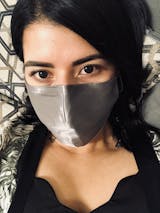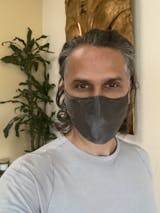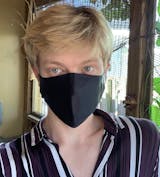Most of us automatically think of gold when we think about precious metals. Gold is a valuable commodity and is considered a good investment. But another metal often gets overlooked and dismissed as less valuable and less precious. That is silver.
What you may not know about silver is it has antibacterial, anti-odor, and anti-microbial properties. And in recent times, brands have discovered a way to infuse their products with silver to reap its health benefits, particularly aiding in the healing of skin conditions like acne.
This article will talk about the history and uses of silver over the centuries. We'll explain how you can treat acne during your most passive bedtime activity—sleeping—using the best silver ion-infused silk pillowcase on the market.
How Silver Forms in the Earth
Let's go back to elementary school. "Ag" is the element for silver on the periodic table. "Ag" stands for the Latin word "Argentum" and Sanskrit "argunas," which both mean "bright," a very fitting word to describe silver.
You may have learned in school that the Earth's core is incredibly hot (approximately 9,392˚F). The Earth has rivers of saltwater coursing through its crust (1). This brine solution contains silver compounds in a dissolved state. The silver compound releases and converts to a mineral state as the solution escapes from the Earth and into the cold seawater.
Although silver is known to be bright and shiny, when silver is mined, it often appears as dark gray or black soot in color—the same way silver jewelry can turn black over time. This is a reaction to oxygen and does not affect the quality of the compound in any way (2). Due to its base ore material being of the same constituent, it is often found alongside gold, and other minerals, such as quartz and ruby.
Silver is found in many parts of the world. But during the Industrial Revolution, most of the silver mines across Europe had become exhausted. Today Mexico, China, and Peru are the top silver-producing mines, producing commercial fine-grade silver that is 99.9% pure.
Historical Uses for Silver
Something else you may not have known about silver before reading this article is it has unique and powerful properties. For many millennia, silver was used as a skin-healing ingredient. When applied topically to the skin, it can facilitate UV protection, infection control, and healing from skin conditions like acne. As mentioned above, this is because silver is naturally antibacterial and anti-inflammatory.
In more recent times, silver has been used as an odor-repellent in clothing and is also said to promote collagen stimulation and has antioxidant properties that are important for protecting the skin from free radical damage. So you may have come across skincare infused with silver.
Silver has been used throughout history for many other purposes, too. The first evidence of silver being used dates back to ancient times. India, China, and Japan are the first civilizations to mine silver. Ancient Turkey and Greece also used silver for jewelry, silverware, clothing and outfit embellishments, and food and beverage vessels. Silver also became a material used for currency in most ancient and modern civilizations.
During the 16th Century, the Spanish looted Aztec and Incan tribes of their silver and forced labor onto the natives to mine silver for them in Bolivia. 16.3 million pounds of silver were shipped to Spain during that time.
When children were baptized, godparents from wealthier families would give their godchild a silver spoon. This is where the phrase "born with a silver spoon in their mouth" originated from.
You may have also seen films where werewolves could only be killed by being stabbed with a silver stake to the heart. This is not something that was invented by Hollywood. This story originated from traditional folklore.
Today, because of its versatile nature, silver is used in many applications. We still use silver to make jewelry and silverware, much like our ancient ancestors. But now, thanks to technological advancements, we also use silver in solar and nuclear energy, photography, antibiotics, electronics, sanitization, and, more recently, textiles.
Silver in Textiles
As mentioned before, Ancient civilizations used silver and gold to decorate their outfits by creating threads and embellishments from metallic compounds, like silver and gold. These were often used as a cultural ritual and were more common amongst royal members of society.
Today, we still use silver, gold, and other metals to decorate outfits. But because of silver's unique skin benefits (3), we're starting to see silver make its way into more than just our skincare and clothes.
Silver Ion-Infused Technology
Silver ion-infused means something has been made using silver ions (atoms). When brands talk about silver ion-infused fabric, generally, it contains silver threads. Silver is incredibly malleable, so forming this compound into thin strands is easier than you'd think. These threads of silver are then woven alongside standard fabric threads, like cotton or silk, to create a piece of fabric, which is then made into a product.
One of the products you may have seen popping up is silver ion-infused pillowcases. Our pillowcases can become harbors for some pretty funky bacteria if we don't wash our bedding regularly. This can be incredibly problematic for anyone who suffers from acne or inflamed skin. So it makes complete sense to have an acne solution infused into the one product where we spend a third of our life.
Silver ion-infused technology sounds incredibly scientific. But let me break it down for you in simple terms.
Bacteria is a single-celled organism that contains chromosomes, cytoplasm, and a few other scientific elements that I won't get into in this article. These elements are all confined within the bacteria's cell wall. The way bacteria spreads is, it replicates its DNA within the cell, and then the entire bacterium splits in half and separates, literally doubling in size. If you're interested, Google "bacteria reproducing" and find plenty of videos on YouTube.
Silver is a naturally-occurring antibacterial compound. Silver is 99.97% effective in reducing the number of bacteria that can replicate. When this technology is infused into the fabric, it gives the product an effective layer of protection against bacteria.
The Best Silver Ion-Infused Pillowcase
When looking for a pillowcase infused with silver ions, you want the fabric to be the best fabric to facilitate silver ion technology.
Let's first look at a pillowcase without silver ion technology. Our research shows that the best fabric for bedding is 100% silk. Silk is:
- Naturally antibacterial and antimicrobial, great for skin conditions like acne.
- Hypoallergenic, perfect for those with allergies.
- Naturally wicking, so it's great for hot sleepers.
- Won't absorb moisture or your skincare products like cotton does.
- A renewable resource and more sustainable than other fabrics, like cotton.
Many silk pillowcases are available on the market, but I invite you to read all about our amazing 30-momme silk pillowcases here. 30-momme silk is the highest grade silk on the market and stays soft no matter how many times you wash it.
We have designed our latest silk pillowcase with 30-momme silk and silver ion-infused technology. You'll get all of the benefits of silk and silver simultaneously. It's a passive acne treatment so you can heal your skin while you sleep.
A Complete Acne Ritual
While we're talking about healing acne, you must be using effective products on your skin in tandem with your passive pillowcase treatment. It can be tempting to scrub your skin and cleanse it with harsh cleansers when you're suffering from a breakout. But what acne needs is calming, soothing, and nurturing. So here are some effective skincare products to add to your ritual before going to bed.
M.S.Skincare's Mantra Skin Perfecting Cleanser
Use this morning and night to cleanse away impurities without stripping your skin of its important protective barrier. This cleanser will calm inflammation and remove bacteria with ingredients like neem and seaweed.
Earthwise Beauty's Catharsis Face Mask
Following your cleanser, use Earthwise Beauty's Catharsis Face Mask to give your skin a healing and hydrating boost. Treat your skin kindly with natural active ingredients of aloe, neem, spirulina, and green algae.
Earth Harbor's Nebula Clarity Ampoule
Use Earth Harbor's Nebula Clarity Ampoule after rinsing your face mask off. This serum is formulated with botanicals like ginseng and sea lavender to heal inflammation, clear congestion, and fight breakouts while you sleep.
Earthwise Beauty's Ambrosia de Cerrado Moisturizer
The final step in your nighttime ritual should be a nourishing and soothing moisturizer. Earthwise Beauty's Ambrosia de Cerrado Moisturizer is formulated with unique botanicals known for their nutrient-dense properties.
Giving your inflamed, acne-prone skin some gentle TLC every night before you lay your head down on a 30-Momme Silver Ion-Infused Silk Pillowcase will be your best defense against helping heal your acne.
Fait avec Coeur's silk products are OEKO-TEX®, BSCI, and ISO certified.
Emma Jade has been a trained esthetician for over 15 years. She is a sustainable skincare writer, educating and building awareness around proper skin health that doesn't cost the Earth.
Some of the products promoted in our blog are from our online store. Many others are brands we have researched and found to be great examples of sustainable, ethical, and innovative brands in their field, and we don't profit from mentioning them in our blog. #CollaborationOverCompetition










